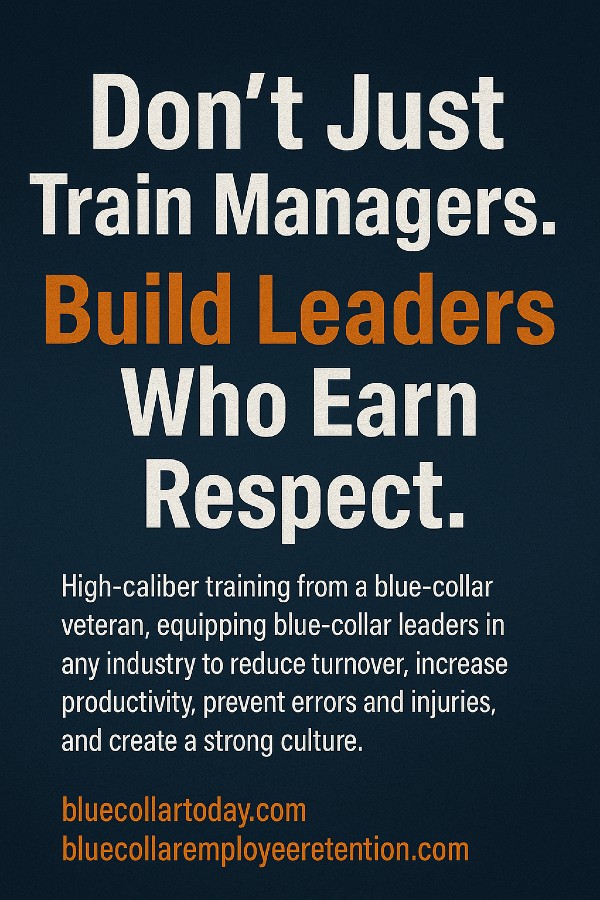
Great Leaders Teach, Not Preach
Why the Best Leaders Know the Jobs They’re In Charge Of
In blue-collar industries, leadership doesn’t come from a corner office, it comes from the trenches.
The best leaders don’t just bark orders from the safety of a clipboard. They’ve worn the boots, carried the weight, and done the job.
They don’t need to preach, because they’ve lived it. And that’s why their teams listen.
Great leaders teach.
They don’t stand on a pedestal; they stand shoulder to shoulder. And in a world where turnover is rising and employee loyalty is harder to earn, that kind of leadership isn’t just admirable—it’s essential.
Experience Builds Credibility
In manufacturing, steel, construction, logistics, or any skilled trade, credibility is everything.
You can’t fake it.
A leader who understands the physical demands, mental pressure, and technical nuances of the job earns instant respect. When someone says, “I’ve been there,” and can actually back it up, the crew pays attention.
But when leadership is disconnected from the reality of the work – when they don’t know how long something really takes, or what corners get cut under pressure – they lose credibility fast.
And when a leader loses credibility, they lose influence.
Preaching Doesn’t Inspire. Teaching Does.
Anyone can bark rules, quote policies, and repeat what the manual says.
But preaching doesn’t change behavior. Teaching does.
Teaching means:
- Showing someone how to handle a tough customer, not just telling them to “stay professional”
- Coaching a new forklift driver through a tight turn, instead of scolding them for being slow
- Helping a welder improve technique, instead of complaining about rejects
Teaching builds capability. Preaching builds resentment.
Great leaders take time to explain, demonstrate, and develop. Not because it’s easy—but because it builds a team that knows what it’s doing and respects who’s leading them.
Teaching Requires Humility
To teach, you have to remember what it was like not to know.
That requires humility. And humility is the secret weapon of real leadership.
It’s what separates a boss who says, “Figure it out,” from a leader who says, “Let me show you what helped me when I was starting out.”
One builds a wall. The other builds trust.
In blue-collar environments, where pride, pressure, and production all collide, humility is the difference between a crew that follows orders and a crew that buys in.
It’s Not About Being the Smartest, It’s About Being the Most Useful
Great leaders don’t have to know everything. But they do need to know enough to be helpful.
When a production line stops or a jobsite hits a snag, the team doesn’t need someone quoting policy—they need someone who can problem-solve in the moment, someone who understands the stakes and can move the team forward.
Being useful isn’t about having a degree or title. It’s about knowing:
- How to calm a tense situation
- How to talk to people with respect
- How to ask the right questions
- How to model the right behavior
And yes, it’s about being able to jump in—hands-on—when it counts.
Leadership by Example Is Still the Gold Standard
The job site doesn’t need more managers. It needs more mentors.
Leaders who walk the floor, stay curious, and stay connected to the work are the ones who build strong, loyal, high-performing teams.
Why? Because people remember how you made them feel. And when you’ve got a leader who teaches instead of preaches—who invests instead of instructs—people feel capable. They feel respected. They feel like they belong.
And people who feel like they belong? They stay. They work harder. They take pride.
That’s the kind of culture that wins.
Final Word: Want to Lead Better? Start Teaching.
If you’re in a leadership position, ask yourself:
- Can I teach the jobs I manage?
- Do I invest in helping others grow, or do I just enforce rules?
- When things go wrong, do I guide—or do I judge?
Because in the end, great leadership is measured not by how loud you talk, but by how well you teach.
Great leaders don’t preach from the front. They teach from beside.
That’s where real influence lives. That’s how cultures are built. And that’s how teams win together.
Jeremy L. Davis
25-Year Blue-Collar Veteran
Founder, Blue Collar Today | Blue Collar Employee Retention





